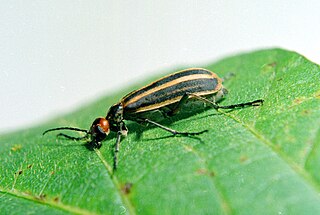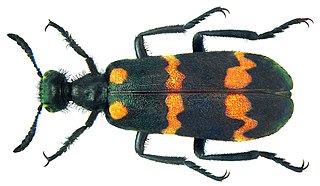
The Spanish fly is an emerald-green beetle in the blister beetle family (Meloidae). It and other such species were used in preparations offered by traditional apothecaries, often referred to as Cantharides or Spanish fly. The insect is the source of the terpenoid cantharidin, a toxic blistering agent once used as an aphrodisiac.

Cantharidin is an odorless, colorless fatty substance of the terpenoid class, which is secreted by many species of blister beetles. It is a burn agent or a poison in large doses, but preparations containing it were historically used as aphrodisiacs. In its natural form, cantharidin is secreted by the male blister beetle and given to the female as a copulatory gift during mating. Afterwards, the female beetle covers her eggs with it as a defense against predators.

Blister beetles are beetles of the family Meloidae, so called for their defensive secretion of a blistering agent, cantharidin. About 7,500 species are known worldwide. Many are conspicuous and some are aposematically colored, announcing their toxicity to would-be predators.

The family Oedemeridae is a cosmopolitan group of beetles commonly known as false blister beetles, though some recent authors have coined the name pollen-feeding beetles. There are some 100 genera and 1,500 species in the family, mostly associated with rotting wood as larvae, though adults are quite common on flowers. The family was erected by Pierre André Latreille in 1810.

Hycleus polymorphus is a species of Blister Beetles belonging to the family Meloidae subfamily Meloinae.

Lytta nuttalli, or Nuttall's blister beetle, is a species of North American beetle first described in 1824 by Thomas_Say. The genus Lytta is from a Latin word suggesting madness The specific nuttallii recognizes the contributions of Thomas Nuttall, a contemporary of Say.

Hycleus is a genus of blister beetle belonging to the Meloidae family found in Africa and Asia. The genus contains over 400 species, which historically have been confused with the genus Mylabris.

Epicauta vittata is a species of beetle in the family Meloidae, the blister beetles. It is native to eastern North America, including eastern Canada and the eastern United States. It is known commonly as the striped blister beetle and the old-fashioned potato beetle. It is known as an agricultural pest.

Berberomeloe is a genus within the tribe Lyttini of the family Meloidae, the oil or blister beetles. It includes two species, the red-striped oil beetle, Berberomeloe majalis, and the less flamboyant Berberomeloe insignis.

Berberomeloe majalis, the red-striped oil beetle, is an insect in the genus Berberomeloe, in the family of Blister Beetles. It is native to the western Mediterranean Basin.

Ceroctis capensis, or spotted blister beetle, is diurnal and endemic to Southern Africa occurring in diverse habitats, and belonging to the Meloidae or Blister beetle family. It secretes a toxic liquid from its leg joints when roughly handled, blistering human skin. This species somewhat resembles Mylabris oculata, a member of the same family.
Meloe franciscanus is a species of blister beetle in the family Meloidae. It is found in the deserts of the southwestern United States. The larvae are parasites of bee larvae, eating them and consuming their provisions.

Tegrodera aloga, the iron cross blister beetle, is a species of blister beetle in the family Meloidae. It is found in Central America and North America.

Mylabris variabilis is a species of blister beetle belonging to the Meloidae family.

Apalus bimaculatus, the early blister beetle, is a species of blister beetle from the family Meloidae. It is the type species of the genus Apalus.
Hycleus phaleratus, is a species of blister beetle found in China, Thailand, Indonesia, Nepal, India, Sri Lanka, and Pakistan.
Mylabris thunbergi is a species of blister beetle found in India, and Sri Lanka.

Mylabris pustulata, is a species of blister beetle found in India, Sri Lanka, China and Java.
Hycleus rouxi, is a species of blister beetle found in India, and Sri Lanka.

Meloetyphlus fuscatus, the blind blister beetle, is a species of blister beetle in the family Meloidae found in Central and South America. They are kleptoparasites of orchid bees and are entirely blind as adults. Unique among meloids, females do not lay their eggs near flowers, but rather within their hosts' nests.















